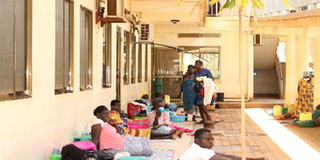Lira Hospital where 2 doctors deliver 600 mothers per month

Expectant mothers wait for services at Lira Hospital’s maternity unit on October 21. PHOTO | CHARITY AKULLO.
What you need to know:
- The government hospital conducts 600 deliveries per month, with an average of eight mothers whose deliveries may require theatre per day. However, there are only two obstetricians with one volunteer to manage these mothers.
Lira Regional Referral Hospital is still grappling with a shortage of medical doctors to manage expectant mothers who are unable to have normal deliveries.
The government hospital conducts 600 deliveries per month, with an average of eight mothers whose deliveries may require theatre per day. However, there are only two obstetricians with one volunteer to manage these mothers.
Dr James Okello, an obstetrician and gynaecologist at Lira Regional Referral Hospital, said Lango is one of the sub-regions in the country with the highest fertility rates. As a result, a large number of expectant mothers deliver at Lira Hospital.
“The challenge is still the common song, which we are currently trying as much as possible to avoid: shortage of staff. And we have always asked ourselves when are we going to be enough beyond what we call a thick skin to serve?” Dr Okello wondered on Friday.
“We are only three specialists: two recruited by the government and one is a volunteer although we are supported by Lira University Teaching Hospital, which has offered us one specialist, still the number is not enough,” added.
Dr Okello was welcoming a team from Stanbic Bank Uganda who had donated three delivery beds, three mattresses with PVC cover, 100 mama kits, a phototherapy machine and steriliser worth Shs14 million to the hospital’s maternity unit.
The support is geared towards supporting the government’s effort to save lives in Uganda through reducing maternal and infant mortality in the region.
There are 16 midwives at the maternity unit and yet labour suit delivery per day is between 20 and 25.
“Every day, we have an average of eight mothers whose deliveries may require theatre. So, preparation for theatre is a big challenge. Remember that when a mother comes to this unit, most of them, especially the first timers do not know that they are going to theatre and they don’t come prepared,” Dr Okello explained.
Amid these challenges, the hospital has a very supportive team, he added.
Bank staff
Mr Damoni Kitabire, a member of the executive board at Stanbic Bank Uganda, said one in 49 women in Uganda dies as a result of pregnancy due to childbirth complications.
“Therefore, to address this challenge, Stanbic Bank launched the every mother counts campaign in the realisation that it’s our responsibility to step up and take up the initiative to improve maternal health in Uganda,” he said. He said reports indicate that Lira health facilities have continued to struggle to manage expectant mothers because of the poor availability of essential maternal and reproductive health equipment.
“We strongly believe that safe motherhood is a vital pillar if we are to have a healthy and prosperous nation. And the handover we are having today is part of maternal and newborn essential supplies and equipment,” Mr Kitabire added.
Mr Benard Ogwal, the regional manager of Stanbic Bank for northern Uganda, said: “I want to say that as Stanbic Bank, anything that we think is dear to us in regards to maternal health, we will continue supporting.”
Ms Juliet Atoo, a representative board of directors of Lira Regional Referral Hospital, urged the staff at the facility to be accountable by putting the equipment into proper use.
According to the World Health Organisation, Uganda’s doctor to patient ratio is 1:25,000 while the nurse to patient ratio is 1:11,000. This, WHO, says is far below the recommended doctor-patient ratio of 1:1000.
what govt says
But Dr Diana Atwine, the Permanent Secretary in the Ministry of Health, said although the ministry is aware of the acute shortage of health workers in government health facilities, they are not about to recruit more staff due to financial constraints. Dr Atwine made the revelation in May after receiving Maama kits worth Shs30m donated to Kawempe Referral Hospital by Stanbic Bank.




